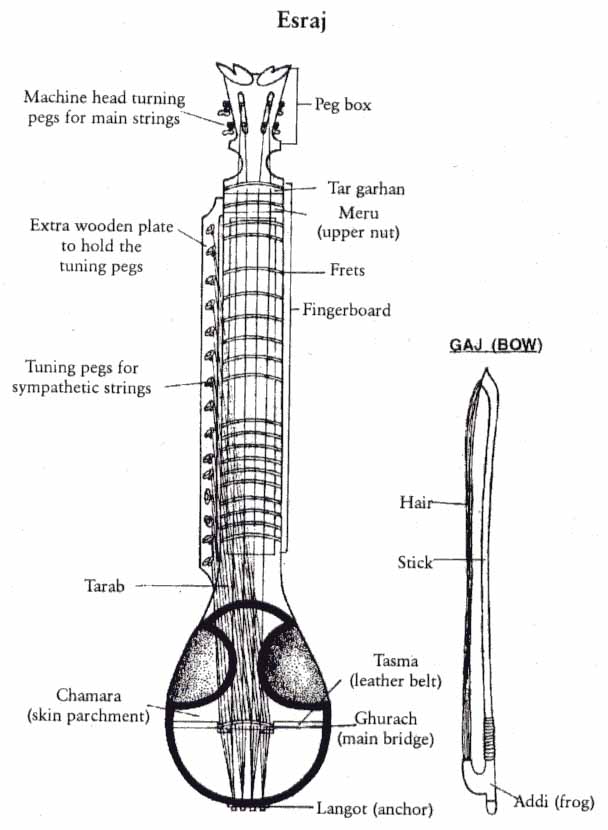The following text is taken from the book "Classical Musical Instruments" by Suneera Kasliwal, Delhi 2001.
Dilruba, Esraj
Dilruba and esraj have combined characteristics of the sitar and sarangi. These have long necks, frets and metal strings of the sitar, but unlike the sitar, they have a soundbox with parched skin and are played by bow like the sarangi. The instruments appeared on the Indian musical scenario in the nineteenth Century.
The instrument dilruba became a regular part of Sikh devotional music and the esraj became very popular in Bihar and Bengal about hundred or hundred and fifty years ago.
As far as classical music is concerned, both these bowed instruments could never achieve much popularity as solo Instruments. As accompanying instruments as well these two had a very short span of life. Today, although they are not obsolete, they are definitely very rare.
The instruments esraj and dilruba emerged in Hindustani music about two hundred years ago with common features of the sarangi and sitar. These Instruments came about because of the particular demand of society in that era. First there was no bowed instrument other than the sarangi on the classical music scene in the nineteenth Century. Second, the sarangi was a difficult instrument to tune as well as to play. The frets on the esraj and dilruba, however, were easier to play than the sarangi. Moreover the status of sarangi on the social scale was very low due to its association with low caste musicians and dancing girls. Thus, these instruments served the particular musical needs of the society of a particular period. Later on, when the violin and harmonium appeared on the music scenario, their popularity gradually waned.
Although both these instruments, i.e. esraj and dilruba, bear almost twin technical characteristics, there are a few differences which justify their having two separate identities.
Dilruba & Esraj in our catalogue
The similarities and differences in both the instrumentsare as follows:
Similarities:
- Both the instruments emerged after combining the features of sarangi and sitar. Both have a long fingerboard with frets and parched skin soundbox, and are played with the bow. Strings are made of metal instead of gut and sound is produced with the help of the left hand fingertips like the sitar.
- The wood used for making the structure is tun or sagwan. The body is divided into two parts, i.e. the fingerboard called dand, and the soundbox called kundi or pyala. The portion where the two pieces are joined is called 'gulu', which is an important joint and has to be done very carefully. The soundbox is covered with parched goat skin and the bridge is fixed in the middle of this skin. The bridge is thin like that of the sarangi. The main strings rest on the grooves made on the bridge, while the sympathetic strings pass through the holes drilled in the bridge. An extra belt of leather is fixed tightly under the bridge and nailed on the corners of the soundbox to give extra support to the leather under the bridge. In the esraj this belt is put on the skin, whereas in the dilruba the belt is often fixed on the inside of the skin, and is not visible
- The number of frets in both the instruments is the same, which varies from seventeen to nineteen. These eliptical frets are made of metal, and like the sitar, they can be moved up and down as and when required.
- The techniques of playing both the instruments are the same. The bowing is done with the right hand and the left hand's fore and middle fingers slide upon the strings and frets longitudinally. The frets are only to give the player an idea about the positioning of the note. The strings are never pulled like sitar. Almost all the finer nuances of the sarangi can be played upon this instrument, while the presence of frets facilitate some of the sitar-like techniques such as cut notes in this Instrument. Thus, both the styles, gayaki (vocal) and tantra (instrumental), can be played upon it.
- The holding position of the esraj and dilruba is almost the same. The instrument is placed either on the lap or in front of the player and the fingerboard rests on the left shoulder.
- An extra wooden strip is added to the side of the fingerboard to accommodate the tuning pegs of the sympathetic strings in both the Instruments.
Differences:
- The main difference between the esraj and dilruba is the shape of their soundbox. The dilruba has a broad rectangular or rather trapzoid sarangi-like sound box, whereas the esraj has a roundish, oval- shaped sound box which is cut from the sides to facilitate bowing.
- The fingerboard of the dilruba is broader than that of the esraj in order to accomodate more sympathetic strings.
- Though most of the dilrubas have four main playing strings like the esraj, but in some dilrubas we find six main playing strings. The number of sympathetic strings also varies. In the esraj we get fifteen sympathetic strings, whereas in dilruba we have twenty to twenty-two sympathetic strings, because of which it has more resonance than the esraj. The arrangement and tuning of sympathetic strings in the dilruba is more or less like the sarangi.
- The shape of the bow of the esraj is quite different from that of the dilruba. As discussed earlier, the dilruba is more popular in western India, but the esraj is popular in the eastern regions like Bihar, Bengal, Orrisa, and Assam.

